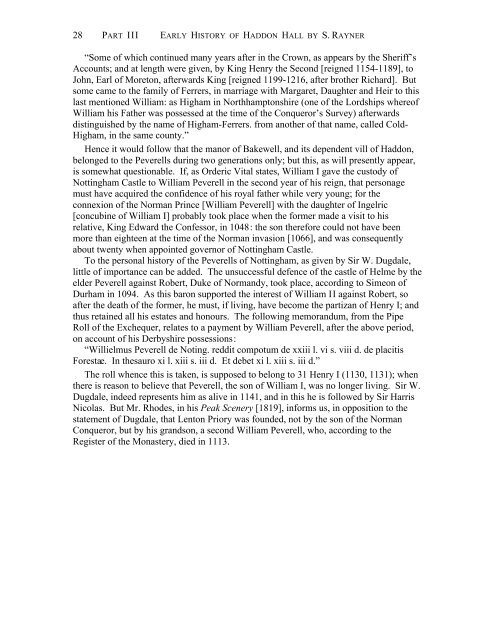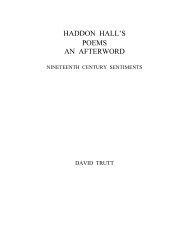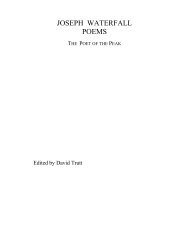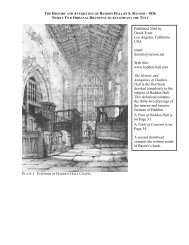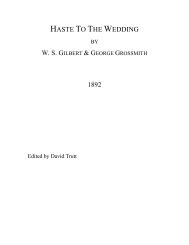Download - Haddon Hall
Download - Haddon Hall
Download - Haddon Hall
You also want an ePaper? Increase the reach of your titles
YUMPU automatically turns print PDFs into web optimized ePapers that Google loves.
28 PART III EARLY HISTORY OF HADDON HALL BY S. RAYNER<br />
“Some of which continued many years after in the Crown, as appears by the Sheriff’s<br />
Accounts; and at length were given, by King Henry the Second [reigned 1154-1189], to<br />
John, Earl of Moreton, afterwards King [reigned 1199-1216, after brother Richard]. But<br />
some came to the family of Ferrers, in marriage with Margaret, Daughter and Heir to this<br />
last mentioned William: as Higham in Northhamptonshire (one of the Lordships whereof<br />
William his Father was possessed at the time of the Conqueror’s Survey) afterwards<br />
distinguished by the name of Higham-Ferrers. from another of that name, called Cold-<br />
Higham, in the same county.”<br />
Hence it would follow that the manor of Bakewell, and its dependent vill of <strong>Haddon</strong>,<br />
belonged to the Peverells during two generations only; but this, as will presently appear,<br />
is somewhat questionable. If, as Orderic Vital states, William I gave the custody of<br />
Nottingham Castle to William Peverell in the second year of his reign, that personage<br />
must have acquired the confidence of his royal father while very young; for the<br />
connexion of the Norman Prince [William Peverell] with the daughter of Ingelric<br />
[concubine of William I] probably took place when the former made a visit to his<br />
relative, King Edward the Confessor, in 1048: the son therefore could not have been<br />
more than eighteen at the time of the Norman invasion [1066], and was consequently<br />
about twenty when appointed governor of Nottingham Castle.<br />
To the personal history of the Peverells of Nottingham, as given by Sir W. Dugdale,<br />
little of importance can be added. The unsuccessful defence of the castle of Helme by the<br />
elder Peverell against Robert, Duke of Normandy, took place, according to Simeon of<br />
Durham in 1094. As this baron supported the interest of William II against Robert, so<br />
after the death of the former, he must, if living, have become the partizan of Henry I; and<br />
thus retained all his estates and honours. The following memorandum, from the Pipe<br />
Roll of the Exchequer, relates to a payment by William Peverell, after the above period,<br />
on account of his Derbyshire possessions:<br />
“Willielmus Peverell de Noting. reddit compotum de xxiii l. vi s. viii d. de placitis<br />
Forestae. In thesauro xi l. xiii s. iii d. Et debet xi l. xiii s. iii d.”<br />
The roll whence this is taken, is supposed to belong to 31 Henry I (1130, 1131); when<br />
there is reason to believe that Peverell, the son of William I, was no longer living. Sir W.<br />
Dugdale, indeed represents him as alive in 1141, and in this he is followed by Sir Harris<br />
Nicolas. But Mr. Rhodes, in his Peak Scenery [1819], informs us, in opposition to the<br />
statement of Dugdale, that Lenton Priory was founded, not by the son of the Norman<br />
Conqueror, but by his grandson, a second William Peverell, who, according to the<br />
Register of the Monastery, died in 1113.


